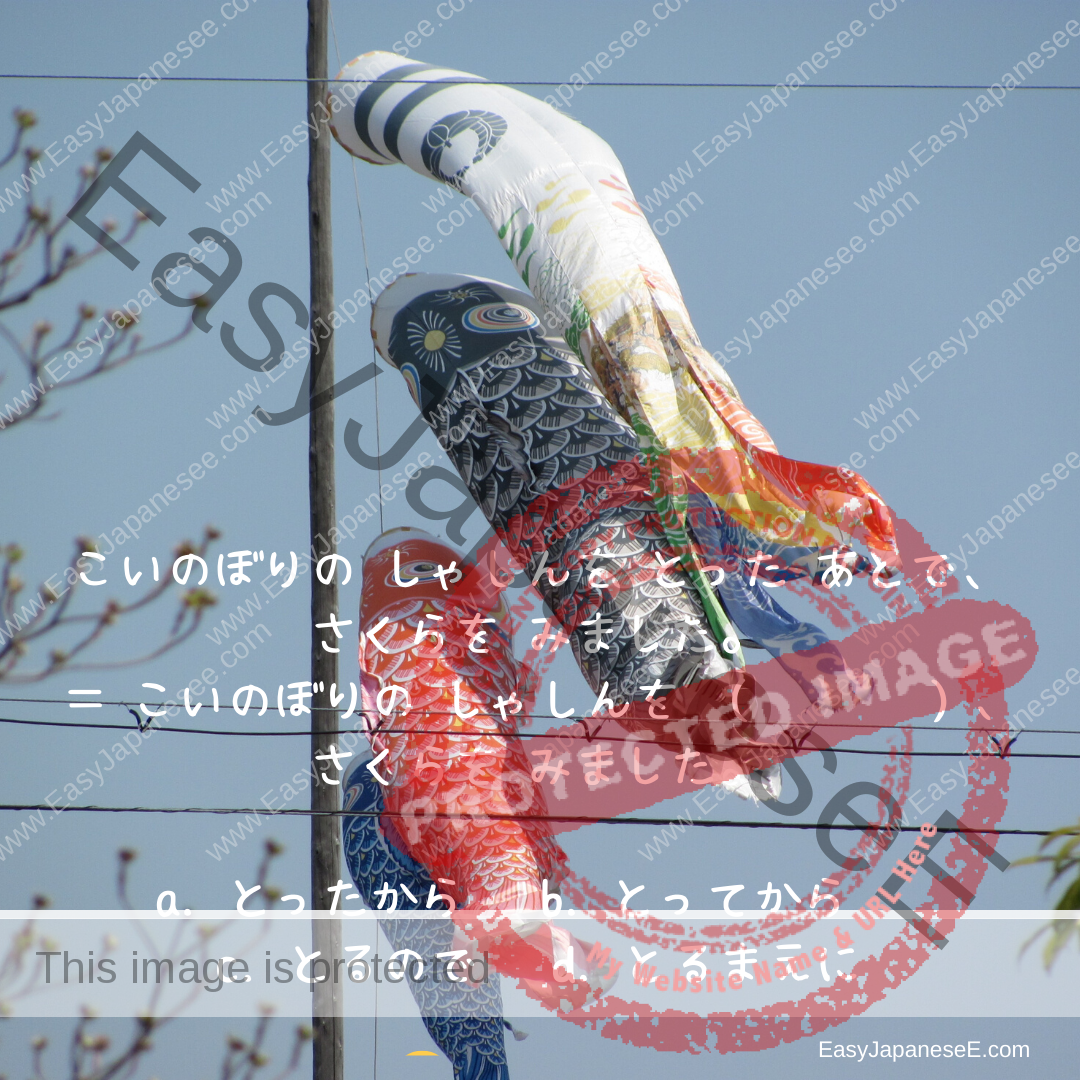こいのぼりの しゃしんを とった あとで、さくらを みました。
= こいのぼりの しゃしんを ( )、さくらを みました。
a. とったから b. とってから c. とるので d. とるまえに
The answer is b. とってから
Let’s have a look at the translation of each sentence.
こいのぼりの しゃしんを とった あとで、さくらを みました。
= After I took a photo of koinobori, I saw cherry blossoms.a. こいのぼりの しゃしんを とったから、さくらを みました。
= Because I took a photo of koinobori, I saw cherry blossoms. (does not make sense)
b. こいのぼりの しゃしんを とってから、さくらを みました。
= I took a photo of koinobori and then I saw cherry blossoms. (correct answer)
c. こいのぼりの しゃしんを とるので、さくらを みました。
= Because I take a photo of koinobori, I saw cherry blossoms. (does not make sense)
d. こいのぼりの しゃしんを とるまえに、さくらを みました。= Before I took a photo of koinobori, I saw cherry blossoms.
(makes sense but the other way around)
In the N5 level, you need to remember at least these 3 usages of the word から.
1. Used after a noun, it indicates the starting point (time/place)
オーストラリアから きました。
= I am/came from Australia.
シドニーから とうきょうまで くじかん かかります。
= It takes 9 hours (to go) from Sydney to Tokyo.
がっこうは くじから です。
= School is from 9 o’clock. (School starts at 9 o’clock.)
くじから さんじまで がっこうで べんきょうします。= We study at school from 9 o’clock to 3 o’clock.
2. Used after a verb in the てform, it indicates the chronological order of actions.
しゃしんを とってから さくらを みました。
= I took a photo and then I saw cherry blossoms.
がっこうに いってから しゅくだいを しました。= I went to school and then did my homework.
3. Used after a plain form clause (non-past or past), it indicates the cause/reason.
みんなの しゃしんを とるから、 きてください。(used after a dictionary form verb)
= As I take a photo of everyone, please come.
みんなの しゃしんを とったから みにきてください。(used after a past plain form verb)
= As I took a photo of everyone, please come and have a look.
さむいから、なかに はいりましょう。(used after a dictionary form i-adjective)
= As it is cold, let’s go inside.
さむかったから、なかに はいりました。(used after a past tense i-adjective)
= As it was cold, we went inside.
この やさいは しんせんだから おいしい ですよ。(used after a na-adjective + だ)
= As this vegetable is fresh, it is delicious.
その やさいは しんせんだったから おいしかった ですよ。(used after a na-adjective + だった)= As that vegetable was fresh, it was delicious.
まだ こどもだから、よくわからないでしょう。(used after a noun + だ)
= As he is still a child, he won’t understand it very well.
まだ こどもだったから、よくわかりませんでした。(used after a noun + だった)= As I was still a child, I didn’t understand it very well.
If you liked this article, please share it with your friends using the social media buttons below.
Also, your clicks on ads on this page help covering the cost of running this website. Your support will be much appreciated.

